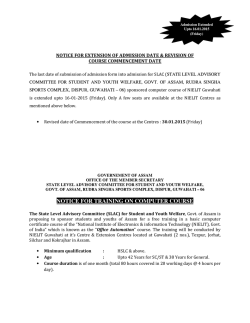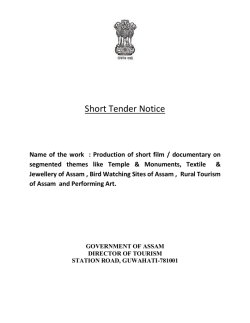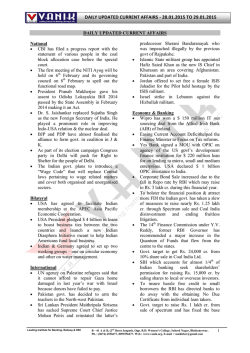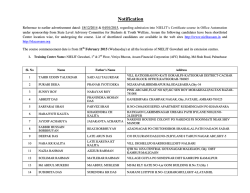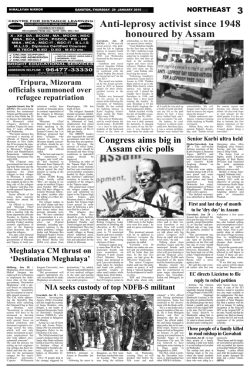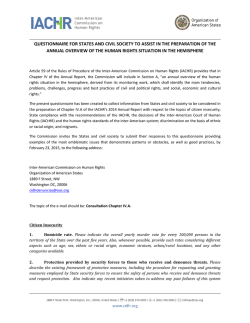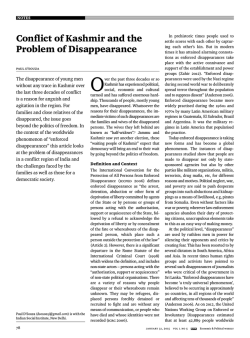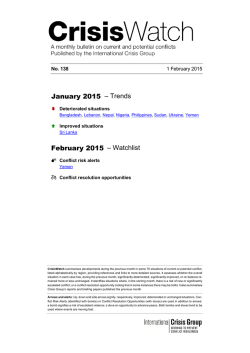
Ethnic Militancy in Assam - Economic and Political Weekly
COMMENTARY Ethnic Militancy in Assam Whom to Blame? h srikanth The killing of over 70 adivasis in Assam by one faction of the Bodo militants is part of a pattern which has become normalised in Assam and its neighbouring states. This article places the present killings in the historical context of the rise of ethnic militancy and underlines, yet again, the futility of such acts. H Srikanth ([email protected]) teaches at the North Eastern Hill University, Shillong. Economic & Political Weekly EPW JANUARY 31, 2015 You are concerned about infiltrators and not your own people ...they must go back, they are robbing the youths of India of their livelihood – Narendra Modi’s electoral speech in May 2014, referring to Assam Chief Minister, Tarun Gogoi and West Bengal Chief Minister, Mamata Banerjee. What has happened is no small incident of militancy. This is a brazen act of terror and will be dealt with as an act of terror should be. There will be zero tolerance and operations will be intensified against those behind the bloodbath – Union Home Minister, Rajnath Singh’s address in Guwahati on 25 December, 2014 condemning the militant attack on adivasis. I n May 2014 more than 30 Bengali Muslims were gunned down by the Bodo militants in Bodoland Territorial Area District (BTAD). Six months after the incident, in December, the vol l no 5 ultras targeted the adivasis, killing nearly 70 persons – including 21 women and 18 children dead, and forcing more than 70,000 people to take shelter in relief camps. Various political parties, students and youth organisations, and non-governmental organisations (NGOs) in the state criticised the deadly attacks on unarmed adivasis and demanded that the government take action against the Songbijit faction of the National Democratic Front of Bodoland (NDFB-S) indulging in terrorist activities. Rise of Militancy Militancy is not something new to northeast India, but the militants resorting to terrorist acts to achieve their political goals is indeed a recent phenomenon. The Nagas and the Mizos took to insurgency in 1950s and 1960s in pursuit of their demand for independent homelands. The 1970s saw the rise of militancy in the valley areas of Manipur and Assam. Till the 1970s militant groups leading the insurgencies in the north-eastern 17 COMMENTARY states mainly targeted the police, the army and the paramilitary forces, who were identified as representatives of the “colonial” Indian state. No doubt, nonindigenous peoples, living in the insurgency-prone areas, were subjected to illegal “taxation”, extortion and “curfews” by some militant groups, but large-scale killings, looting and forcible eviction of the migrant population were almost unknown till the 1980s. The situation changed during the Assam agitation directed against the socalled foreigners in the period between 1979 and 1985. It was during this supposedly peaceful “Gandhian nationalist movement” that Assam witnessed the ghastly Nellie massacre in 1983, in which over 2,000 Bengali Muslims were killed. What was then considered a spontaneous outburst, or even an aberration, has, since the 1990s, become a regular feature of the politics of Assam and other north-eastern states. In the name of fighting for independence, ethnic integration or separate state status, different militant outfits have started attacking people belonging to other communities, killing unarmed civilians – including women and children, torching their houses and crops, and forcing tens of thousands of people to flee from their villages into refugee camps which change the demography of the region. Although almost all states in the NorthEast have experienced such acts of terrorism, Bodo militancy gets greater attention in national media, partly because of the frequency and intensity of the militant attacks. Trajectory of Bodo Politics The Bodos, one of the tribes inhabiting the plains of Assam, have been fighting for a separate state. It is true that the Bodos view the Bengali Muslim peasants and the adivasis, who were encouraged or forced to migrate to Assam during the colonial period, as encroachers of their ancestral land and other resources. What needs to be remembered is that the Bodo movement that took off in the 1960s was political and non-violent. In fact it was mainly directed against the Assam government. The Bodos then asserted their separate identity and 18 opposed the official linguistic policy that aimed at an Assamisation of the state. That Bodo movement held the state government responsible for the neglect, economic underdevelopment and educational backwardness of the Bodos. Yet during the Assam agitation (197985) the Bodos identified themselves with the Assamese, who invoked Assamese nationalism to fight against the “threat” of “illegal Bangladeshi settlers”. However, almost immediately after the Assam agitation, the Bodo leaders fell apart and began to reassert their separate identity by launching a militant political movement under the guidance of the All Bodo Students’ Union (ABSU) and the Bodo Peoples’ Action Committee (BPAC). While the Bodo leaders attributed the break to the “big-brother” attitude of the Assamese leadership, the latter alleged that Bodo militancy was encouraged and sponsored by the Congress government at the centre with the intention of countering the growth of the Asom Gana Parishad (AGP). In 1993 ABSU-BPAC entered into a bipartite accord that resulted in the formation of the Bodoland Autonomous Council (BAC). But the limited powers granted to BAC did not satisfy the Bodo militants aspiring for a separate state. Their dissatisfaction facilitated the rise of armed militant outfits – the NDFB and the Bodo Liberation Tigers Force (BLTF). These militant groups virtually hijacked the political agenda of the Bodos and took to arms to achieve their political objectives. More than fighting against the government agencies, they started indulging in ethnic cleansing campaigns to achieve their goals. Their first violent assault in 1993-94 was directed against the Bengali Muslims. Later in 1996 and then in 1998 they targeted the adivasis – the descendants of tribals from east-central India brought to work in the tea estates during the 19th century – killing hundreds of people and displacing over two lakh adivasis from their villages. However, Bengali Muslim peasants continued to be their prime targets. Despite the fact that the Bodos constitute only 30% of the population in the areas they claim to be their own, they demanded a separate state defined by their ethnic status. After a hard bargain, in 2003 the BLTF and the ABSU agreed to the formation of the Bodo Territorial Council (BTC), comprising the newly carved out territorial area districts of Kokhrajhar, Baksa, Udalguri and Chirang. The BLTF gave up arms and its leaders even contested and won the BTC elections. But the NDFB rejected the BTC formula and continued its militant activities in pursuit of its demand for a sovereign Bodoland. After the 2008 serial bomb blasts in Guwahati and other places in Assam, the NDFB encountered splits, first in 2008 and then in 2012. When Ranjan Diamary, who earlier headed the Bodo Security Force and then the NDFB for over two decades, agreed to hold talks with the centre, the breakaway faction led by I K Songbijit opposed the talks and started violent New in EPWRF India Time Series Module on Insurance The Economic and Political Weekly Research Foundation has added a module on Insurance to its online database EPWRF India Time Series (EPWRFITS). The Insurance module provides time series and company-wise data under Life and Non-Life Insurance, seperately for both public and private sectors, starting from 2001. The module covers a large number of variables such as the number of offices, policies issued, premium, claims settled, and solvency ratios. Under the category of Life Insurance, company-wise data at the state-level on the number of offices and individual new businesses underwritten is included. Cross-country indicators like insurance density and penetration are given to enable international comparison. The periodicity of data for all variables is annual and has been sourced from publications such as the Insurance Regulatory Authority of India’s Handbook on Indian Insurance Statistics and annual reports. With this, the EPWRFITS now has 14 modules covering a range of macroeconomic and financial data. JANUARY 31, 2015 vol l no 5 EPW Economic & Political Weekly COMMENTARY acts against the non-Bodos in the name of the Bodo nation. The Oxygen Supply Following the violent assaults on the adivasis in December 2014, state and central governments came under tremendous pressure to suppress the activities of NDFB-S. The union home minister flew to Guwahati and ordered intensification of anti-insurgency operations against the banned outfit. After the usual initial blame game, both state and central governments agreed to cooperate with each other. Several suggestions have been made to prevent the recurrence of such attacks. These include a revamp of its intelligence establishment, strengthening of police patrol and civil administration in sensitive villages, improvement in road connectivity and communication set-up in border villages, identification and arrest of those involved in violent crimes, seizure of illegal arms from militants and ex-militants, negotiations with neighbouring countries to step up offensive against the militants’ hideouts in there and ensuring effective coordination between the centre and state agencies while undertaking counter-insurgency operations. To some extent such measures may help in reducing the intensity and frequency of militant attacks. But ethnic militancy is a multi-headed hydra which cannot be put down without striking at the sources that sustain and strengthen its presence. Apart from operational difficulties, what comes in the way of tackling ethnic insurgents in north-east India is lack of political will. It is difficult to take a firm stand against ethnic militants, for most politicians and ruling parties need them for electoral gains. That there is no consistent anti-militant policy becomes clear when one takes a look at the utterances of national leaders. In May 2014 when the NDFB orchestrated riots, Narendra Modi, the then prime ministerial aspirant campaigning in Guwahati did not utter a word against the Bodo militants. Instead he made a wild allegation that rhinos are killed in Assam to make way for illegal Bangladeshi settlers. Taking cue from his speeches, many intellectuals Economic & Political Weekly EPW JANUARY 31, 2015 wedded to the Sangh Parivar started writing blogs depicting all Bengali Muslims, even those settled in Assam before Independence, as Bangladeshis and holding them responsible for the ethnic clashes. These people, however, started responding differently when the same militant group attacked the adivasis in December 2014. Such inconsistencies are the hallmarks of the state leaders as well. So much has been said and written about the link between politicians and militants in north-east India. The leaders’ response to militancy depends not so much on the nature of crimes committed, but on their political relations with the perpetrators or the victims of such crimes. Some political parties and associations in the North-East are ideologically and ethnically so close to certain militant outfits that it is inconceivable to think of any hard-line policy against the extremists. They may at best be critical of militant outfits of other communities, but tend to be soft towards “their own” militant outfits that claim to be fighting for their community interests. Militants exercise considerable hold over local police and government officials too, particularly at the local levels. In May 2014 it was reported that 10 exmilitants who were employed as forest guards by the BTAD government were instrumental in killing several Bengali Muslims. In times of ethnic tensions, it is difficult for politicians, political parties, administrators, police and mass organisations, who are themselves under the influence of ethnic ideologies, to remain neutral and impartial. Sometimes pragmatic considerations to weaken the militant groups also compel the state and central governments to appease the militant leaders and overlook all the crimes committed against the civilians in the name of the greater good of the state. No Conclusion While pointing out the weaknesses of politicians and officials in combating ethnic militancy, one should not forget that ethnic militancy does not end by neutralising particular militant groups. vol l no 5 As long as ethnic ideologies and identity politics continue to influence the minds and actions of people, there will always be someone waiting to take to ethnic militancy. The history of Bodo militancy shows that every time a militant outfit gives up arms, a new faction emerges from within to carry on militant activities. While criticising their violent and sectarian activities, one should not lose sight of the fact that ethnic thinking is fostered not only by ethnic militants, but also by governments, politicians, NGOs and intellectuals of different hues and colours. Unable to offer solutions to the problems of poverty, unemployment, landlessness and underdevelopment in tribal areas, over the years many, including the mainstream leftist parties, have contributed to the illusion that all problems of native communities can be resolved by conceding political autonomy to them, or by granting scheduled tribe (ST) status to all communities claiming to be indigenous. Consequently, not only in Assam, but in other north-eastern states too different communities have began competing with one another seeking ST status and demanding autonomous districts or separate states for themselves. The radicals among them take to ethnic militancy to achieve the goals, without realising that, far from achieving their declared goals their activities only facilitate the rise of militant outfits in the communities they have started targeting. Without an understanding of the dynamics of capitalist market economy and the divisive politics of the ruling classes in India, every community continues to see the others as its enemies and indulges in a zero-sum game where neither the communities claiming to be indigenous nor the communities branded as outsiders/illegal Bangladeshi settlers could live and progress in peace. It is only by involving all oppressed classes and communities of people in the region in alternative militant movements against underdevelopment and politics of divide and rule that one could think of putting an end to ethnic militancy. Unfortunately, it does not seem that politics in the region is yet ripe for that change. 19
© Copyright 2024
